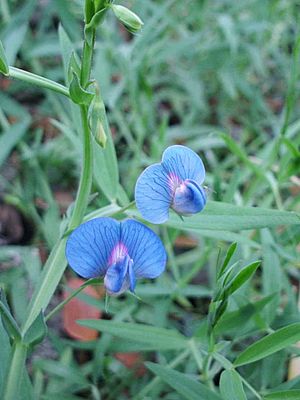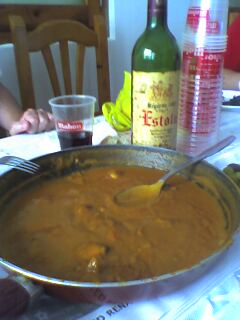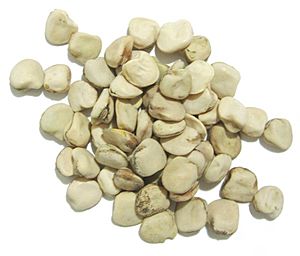Grass pea facts for kids
Quick facts for kids Grass pea |
|
|---|---|
 |
|
| Scientific classification | |
| Genus: |
Lathyrus
|
| Species: |
sativus
|
| Synonyms | |
|
List
|
|
Lathyrus sativus, also known as grass pea or chickling pea, is a type of legume. It belongs to the same plant family as beans and peas. People often grow it for food for themselves and for farm animals. You can find it widely grown in Asia and East Africa.
This plant is very important in places that often have drought or famine. It is called an 'insurance crop' because it grows well even when other crops fail. The Serra de'Conti Cicerchia is a special type of grass pea. It is recognized by the Ark of Taste for its unique qualities.
The seeds of the grass pea contain a natural substance called a neurotoxin. If someone eats only grass peas as their main food for a long time, this substance can cause a health problem. This problem affects the nerves and can make it hard to move the lower body. However, with proper cooking and a balanced diet, grass peas can be eaten safely.
Contents
Growing Grass Pea
Grass pea grows best in places where the temperature is usually between 10 and 25 degrees Celsius. It also needs about 400 to 650 millimeters of rain each year. Like other legumes, grass pea helps the soil by adding nitrogen to it. This makes the soil healthier for other plants.
This plant can survive tough conditions like droughts or floods. But it grows best in soil that is a bit moist. It can grow in many different types of soil. This includes sandy, loamy, or heavy clay soils. It also does well in acid, neutral, or alkaline soils. However, it does not like to grow in shady spots.
A special type of grass pea, the Serra de'Conti Cicerchia, is grown in Italy. The Slow Food organization has added it to their Ark of Taste. This means it is a valuable food that needs to be preserved.
How People Use Grass Pea
Grass pea seeds are sold in markets for people to eat. In Italy, this pulse is eaten in some central areas. However, its use has been slowly decreasing over time.
Flour made from grass peas is called almorta in Spanish. It is the main ingredient for a traditional dish called gachas manchegas. This dish is popular in the La Mancha region of Spain. It is an old, hearty meal often eaten during cold winter months. People usually eat it directly from the pan, using a spoon or a piece of bread.
Because of the natural substance in the seeds, eating grass pea flour was restricted in Spain for human use from 1967 to 2018. However, it was widely used as animal feed. Today, with better understanding and preparation methods, it can be part of a balanced diet.
In Portugal, the town of Alvaiázere holds a festival celebrating dishes made with grass pea. They call themselves the capital of Chícharo, which is the Portuguese name for this pulse.
Young, unripe grass pea seeds can be eaten like green peas. To make L. sativus safe to eat, it needs to be soaked and cooked very well. This helps to reduce the natural substances in the seeds.
The leaves and stems of the plant are also cooked and eaten. In parts of Odisha, India, they are prepared as a dish called chana saga.
Understanding Seed Characteristics
Like other grain legumes, grass pea seeds are rich in protein. However, the seeds also contain a natural substance called β-N-oxalyl-L-α,β-diaminopropionic acid, or ODAP. ODAP is a neurotoxin, which means it can affect the nervous system.
Eating grass pea as the only or main food source for a long time can lead to a condition called neurolathyrism. This is a problem that affects the nerves and can cause weakness or even paralysis in the lower body. This has sometimes happened after famines when people had very little other food. It has been seen in parts of Europe, North Africa, and South Asia. It is still sometimes a concern in places like Eritrea, Ethiopia, and Afghanistan.
The amount of ODAP in the plant can increase when the plant grows in difficult conditions. This makes the problem worse in areas facing food shortages. However, in small amounts, grass pea is usually harmless to humans. Eating it as part of a varied diet does not cause problems.
Scientists are also studying the benefits of grass pea. It is the only known food source for a substance called L-homoarginine. This substance is important for making nitric oxide in the body, which helps with many body functions.
Improving Grass Pea Plants
Scientists are working on special growing programs to make grass pea plants that produce less ODAP. This is called plant breeding.
Some types of grass pea from western Asia naturally have lower levels of this substance. Researchers are using these plants to develop new varieties. The goal is to create grass pea plants that are still tough and can grow in extreme conditions. At the same time, these new varieties will have much lower levels of the natural substance, making them safer to eat.
Wild relatives of the grass pea plant are also being studied. These wild plants can provide valuable genetic material. This material can be used to improve the cultivated grass pea plants. Organizations like the ICARDA are looking for wild grass pea plants. They want to find genes that lead to low or no ODAP. They also look for genes that help plants resist diseases or harsh weather. Then, they can transfer these good genes to the grass pea plants that farmers grow.
See also
 In Spanish: Lathyrus sativus para niños
In Spanish: Lathyrus sativus para niños



